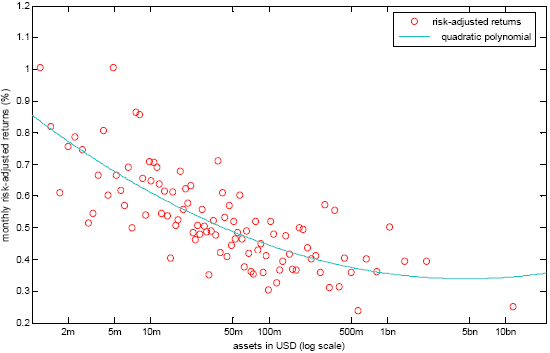Do small hedge funds tend to prosper in their chosen niches while large ones outgrow their opportunity sets? In his January 2009 paper entitled “Does Size Matter in the Hedge Fund Industry?”, Melvyn Teo examines the relationship between hedge fund size and future risk-adjusted (for seven factors) returns. Using monthly net-of-fee returns, assets managed and other characteristics for a large sample of live (3,177) and dead (4,240) hedge funds allocated to four styles over the period January 1994 through June 2008, he concludes that:
- There is a negative, convex relationship between hedge fund size and future risk-adjusted returns (see the chart below). For example, an increase in assets from $10 million to $500 million implies a decrease in annual abnormal returns of about 1.23%.
- A portfolio comprised of the smallest 40% of hedge funds outperforms a portfolio of the largest 40% hedge funds (both rebalanced annually) by a risk-adjusted 3.65% per year.
- Limits on opportunity sets, not fund age or style or leverage, appear to drive the underperformance of large funds. These limits are most evident for funds managed by multiple principals who trade small, illiquid securities (e.g. emerging market securities), suggesting that price impact of trading and compromises in decision-making are decisive factors. The limits appear not to apply to funds of hedge funds.
- While new investments flow disproportionately to small funds, they do not do so quickly enough to eliminate the hedge fund size effect.
- Some hedge fund managers recognize opportunity set limits by adopting higher performance fees and sometimes closing their funds to new investments.
The following chart, taken from the paper, depicts the relationship between hedge fund monthly abnormal (risk-adjusted) returns and assets under management the prior month over the period January 1994 through June 2008. A best-fit quadratic polynomial shows the convexity of the effect (concentration among the smallest funds).

In summary, large hedge funds contend with significant diseconomies of scale, and consequently underperform comparable small hedge funds.